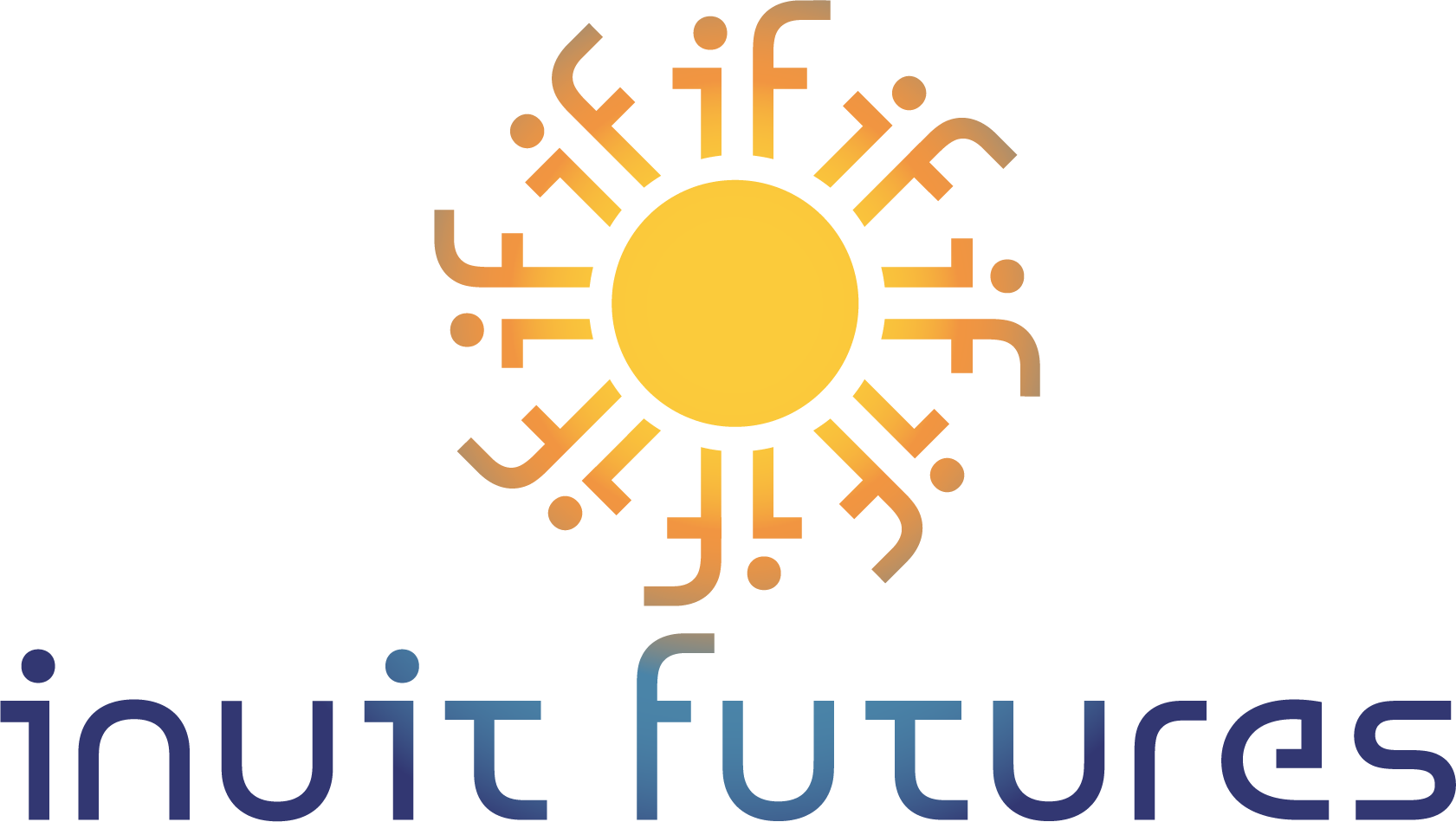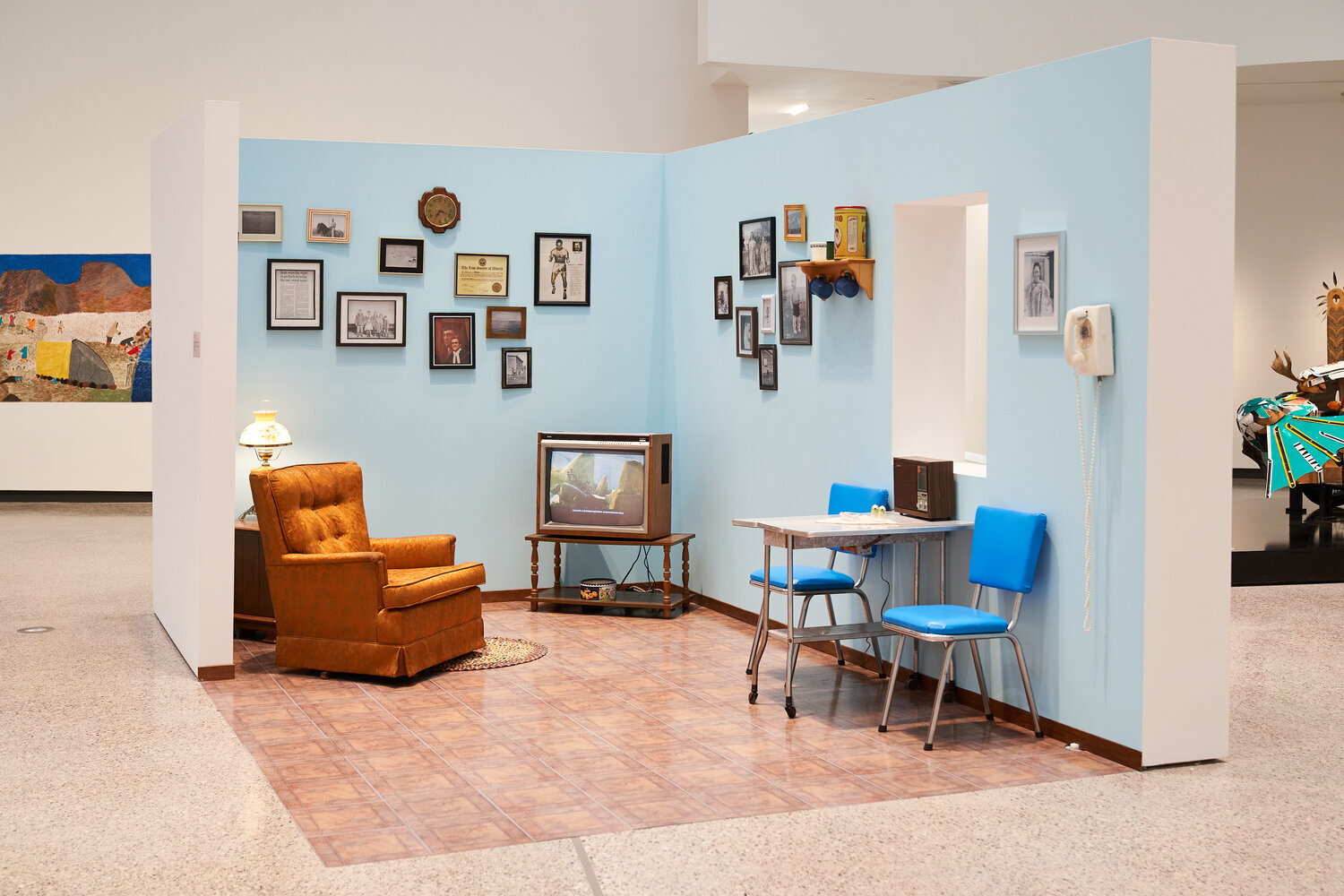INUA Behind the Scenes: Ajjigiingiluktaaqtugut with Lindsay McIntyre, Kajola Morewood and Jennifer Qupanuaq May
Film artist and Inuit Futures mentor Lindsay McIntyre (Inuk and settler Scottish descent) worked with two Inuit Futures Ilinniaqtuit, Kajola Morewood and Jennifer Qupanuaq May, to create a multi-media installation and experimental animation for INUA, called Ajjigiingiluktaaqtugut (We Are All Different).
The installation is a reproduction of Lindsay’s late grandmother’s living room, with a vintage television playing an animated documentary with hand-scratched cell and stop motion animation. The film features audio recordings from interviews with Inuit who explore the idea of belonging and connection to place.
Ajjigiingiluktaaqtugut (We Are All Different) (2020), Lindsay McIntyre, Animation on S16mm to digital video, stereo sound, mixed media. Photo by David Lipnowski.
The film was originally intended to be only six minutes in length, but ended up being seventeen minutes long, which Lindsay says is because “there were so many great components that we really wanted to include, and each of the interviews we recorded was over an hour in length.” Lindsay works with analogue film because she enjoys the tactile elements of animation, and the labour involved with the process. Time and process are really important to her practice, and she says that it was rewarding to have other voices participate in the project.
Details, Ajjigiingiluktaaqtugut (We Are All Different) (2020), Lindsay McIntyre, Animation on S16mm to digital video, stereo sound, mixed media. Photo by David Lipnowski.
The work is part of Lindsay’s ongoing investigation into her family’s past. Jennifer noted that when she saw the final set up of the work, she felt like she was in her grandmother's kitchen. Lindsay says that her intention with the work was for it to be collaborative and interactive. “The idea with the physical space was that it would be sort of welcoming, and would invite people to come in and sit down and think. It's the only piece in the exhibition where you're actually supposed to touch things and come in and sit down and participate.” Lindsay’s aim to make the work accessible and open was in the hope that people who may be experiencing similar feelings about home and place find connections through the work. She says the work is not only for Inuit who live in and outside of Inuit Nunangat, but also for all kinds of people who have been displaced from their home territory.
Kajola Morewood assisting on the landscape materials for an under camera animation component, December 2020.
Kajola Morewood, Photo courtesy of Kajola Morewood.
Kajola Morewood, an Inuk from Nunavik and a full-time master’s student studying Library and Information Studies at the University of British Columbia, assisted Lindsay with the film’s animation and cell scratching. Kajola took transparent cells overtop of a light table and used different scratching techniques to create unique textures and visual imagery, then layered the cells directly over top of each other to create the final animation. Although the majority of the project was done from a distance, Lindsay and Kajola were able to meet in person a couple of times to gather and share materials.
“It was really interesting for me to see Lindsay's process and how she was working, because she had to adapt so much to changes that were thrown at her. To see her maneuver around those obstacles with such a huge project was really interesting,” Kajola says about her experience working with Lindsay.
Kajola came to the work with no previous experience in animation. “It was a real learning curve, and Lindsay was super nice about it. When I was working on it, I hadn't heard any of the interviews and the stories so to see it all come together was surprising and lovely.” Having a creative outlet was a nice compliment to Kajola’s strict academic schedule, and she even says that she would consider exploring creative work similar to this project after she graduates.
Examples of cell scratching, Ajjigiingiluktaaqtugut (We Are All Different) (2020), Lindsay McIntyre, Animation on S16mm to digital video, stereo sound, mixed media. Photos courtesy of Lindsay McIntyre.
“Lindsay’s film has really opened my eyes to the future and what it entails.”
- Jennifer Qupanauq May”
Jennifer Qupanuaq May, an Inuk from Kuujjuaq and full-time student at John Abbott College studying Media Arts, contributed to the recording, translating and editing of the interviews included in the film. Lindsay says that Jennifer had a big role in asking the questions during the interviews. Jennifer lives in Montreal, which allowed her to use recording facilities and speak with Inuktitut speakers in her area, which Kajola and Lindsay weren’t able to do in Vancouver. Jennifer’s translation work allowed Lindsay to interview native Inuktitut speakers and include their voices in the work. She says, “Lindsay's film has really opened my eyes to the future and what it entails.”
Lindsay says the process of making the film was extremely emotional. “I cried multiple times while doing the interviews,” she says, “I think Jennifer did too. It was quite an experience to hear about all of the different experiences of belonging, and not belonging. And so for me, it was healing to connect with people.”
Jennifer Qupanuaq May, photo courtesy of Jennifer Qupanuaq May.
Stop motion animation still, Ajjigiingiluktaaqtugut (We Are All Different) (2020), Lindsay McIntyre, Animation on S16mm to digital video, stereo sound, mixed media.
Hand scratched cell animation still, Ajjigiingiluktaaqtugut (We Are All Different) (2020), Lindsay McIntyre, Animation on S16mm to digital video, stereo sound, mixed media.
Due to the Covid-19 pandemic, neither Lindsay, Kajola nor Jennifer have been able to visit the WAG to see Ajjigiingiluktaaqtugut in person. Lindsay says she is considering extending the work through sharing longer clips from the interviews she conducted for the project, but that this idea is still in the beginning stages of development. Kajola shared her excitement at contributing to such an important inaugural exhibition at Qaumajuq, and hopes that other young Inuit take advantage of opportunities to get involved in the arts. Jennifer encourages young Inuit to think outside the box, and be willing to learn and adapt.
Zoom recordings and distance editing consultations. Clockwise from left: Ujurak Appadoo (interviewee), Lindsay McIntyre, and Jennifer Qupanuaq May, December 2020.
Ajjigiingiluktaaqtugut (We Are All Different) will be on display as a part of INUA at Qaumajuq at the Winnipeg Art Gallery until March 2022. To learn more about INUA, visit The Winnipeg Art Gallery website. To learn more about Jennifer and Kajola’s involvement with Inuit Futures visit our page all about our Illiniaqtuit.
Images courtesy of Lindsay McIntyre
If you are interested in becoming one of our Inuit Futures Ilinniaqtuit, please visit our contact page to get in touch.











